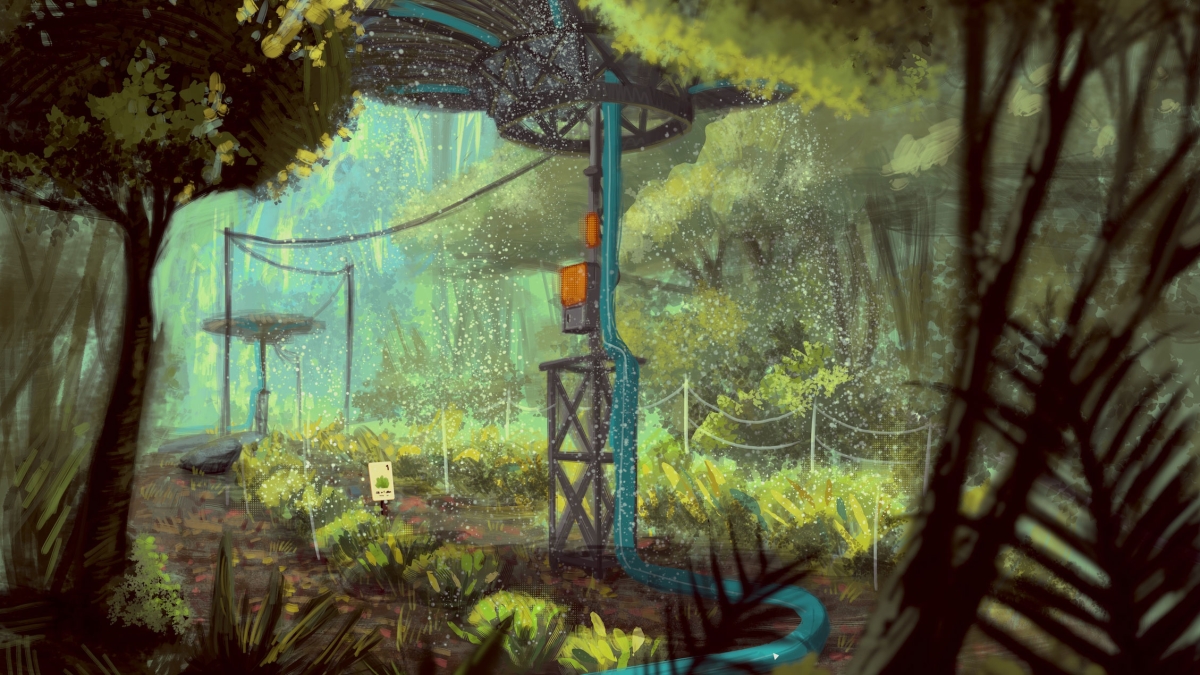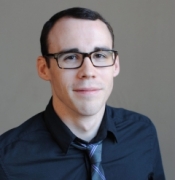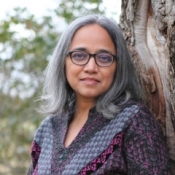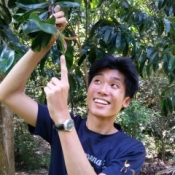New book makes a case for climate optimism

One of a series of images created for “The Climate Action Almanac” by João Queiroz, a digital artist based in Brazil who describes his work as Amazofuturist and solarpunk. This image depicts “agroforestry,” showing a small plot of crops grown ensconced in the surrounding forest ecosystem, rather than destroying it.
It’s a novel idea: recruit acclaimed authors, artists, academics and environmental advocates from around the world and ask them to write positive stories about climate change.
Titled “The Climate Action Almanac,” this new collection seeks to spark positive change by reimagining the future as dynamic, decarbonized and shaped by climate action that grows and spreads up and out from local realities and grassroots efforts.
“The stories and essays in this volume remind us that the effects of the climate crisis are as diverse as the communities and ecosystems under threat, all over the world,” says Joey Eschrich, managing editor for ASU’s Center for Science and the Imagination and assistant director for Future Tense, and one of the book’s editors. “Our contributors dramatize how effective climate action must respond to environmental conditions on the ground, while also resonating with the values and unique needs of real people and actual places. These visions of the future expand our sense of what climate futures are possible, if we think of climate action as starting with complexities and opportunities at the local level.”
The book is presented by the Center for Science and the Imagination at Arizona State University, in partnership with the MIT Press, and supported by a grant from the ClimateWorks Foundation. It’s edited by Eschrich and Ed Finn, director of the Center for Science and the Imagination, with original illustrations by João Queiroz.
The Center for Science and the Imagination is planning a book launch on Jan. 16, hosted with Future Tense, the ClimateWorks Foundation and ASU’s Convergence Lab. Register for the virtual launch, which starts at 1 p.m. Arizona time.
“For many, and especially for young people, climate change is a source of anxiety or even despair,” said Finn, who is also an associate professor at ASU’s School for the Future of Innovation in Society. “With this book, we’re hoping to invite communities around the world to envision their own positive climate futures. We need to practice hope and imagine futures we want, futures we can get excited about and work towards in the present.”
The almanac’s editors sought out narratives about what positive climate futures might look like for communities around the world. The book, which is free to read online, features perspectives on climate futures from authors based in a range of places, each considering their own unique opportunities and challenges for climate action: from China to Wales, Germany to Nigeria, Sri Lanka to Mexico, Malaysia, India, the United States and more.
Vandana Singh, who hails from India but is a professor at Framingham State University in Massachusetts, is one of 26 writers who contributed to the “The Climate Action Almanac.” She saw the book as a “defiant resolve that acknowledges the grim reality” of an existential threat to humanity.
“The powerful elite have already co-opted the climate discourse. What can so-called ordinary people do?” said Singh, who contributed the short story “Mina’s Dream,” about a rooftop vegetable garden in a middle-class neighborhood in Delhi that becomes the foundation for a wide-ranging social and environmental movement, as well as “Three-World Cantata,” a novelette about a mixed-reality experience built by a global collective of scientists and activists, meant to model possible pathways to different climate futures.
“My stories are a study of the contrast between two very different visions of the future — the elitist dream of power and control, and the far more democratic, messy, diverse kaleidoscope of dreams that people at the frontlines of climactic change might have.”
Nalini Chhetri, a clinical professor at ASU’s School for the Future of Innovation in Society and School of Sustainability, also approached the book as an opportunity to share her insights about the climate crisis as a scholar and citizen.
“Writing fascinates me, but I think it is hard to write an interesting and compelling story. I thought that if I had a real experience to offer that it would make for an authentic narrative,” said Chhetri, whose essay blends scientific fact with personal experience to explore the past, present and possible futures in the foothills of the Himalayas, where she was raised.
“I have taught and done a lot of work on climate for many years. So Joey knew this, and when he approached me, I did not say no. I thought, ‘This is an opportunity – let me take it.’”
The result was “Landslides, Terror, and Resilience in the Himalayas,” which chronicles the reality of the extreme weather of Chhetri’s native country. She said the region suffers from monsoons, heavy rainfall, frequent landslides and flooding, as well as triple-digit heat during the summer.
“It can be terrifying because in Phoenix you can duck into an air-conditioned room. That is not an option when you have rain-saturated land and torrential rainfall, and hope your home will not be swept away,” Chhetri said. “Anthropogenic climate change and inequalities can harm us, certainly. But we — humanity — created them both, and we have the power and wherewithal to address them and to bring us back from the brink.”
Benjamin Ong also saw his essay, “The Village Within,” as an opportunity to reflect creatively and critically on the modernization of Malaysia, where he grew up.
“My essay dwells on this question: Is there a future in which we can bring some of the past with us instead of discarding it as backward, and can we be a little less heavy-handed in our design and management of urban landscapes,” said Ong, an ecologist, educator and nature writer currently pursuing a PhD at the University of St Andrews in Scotland. “I think there’s a sense that climate action must come from stories because we’re working towards a future that is ‘not yet.’”
Ong admits that he sees facts and figures about climate change as “anxiety-inducing,” but said a positive story by experts as something that could turn things around.
“Futures — good, bad and everything in between — come from the stories we tell ourselves and share with each other every day,” Ong said. “Who knows where a positive story might lead?”
More Environment and sustainability

A 6-month road repair that only takes 10 days, at a fraction of the cost? It's reality, thanks to ASU concrete research
While Arizona’s infrastructure may be younger than its East Coast counterparts, the effects of aging in a desert climate have begun to take a toll on its roads, bridges and railways. Repairs and…

Mapping DNA of over 1 million species could lead to new medicines, other solutions to human problems
Valuable secrets await discovery in the DNA of Earth’s millions of species, most of them only sketchily understood. Waiting to be revealed in the diversity of life’s genetic material are targets for…

From road coatings to a sweating manikin, these ASU research projects are helping Arizonans keep their cool
The heat isn’t going away. And neither are sprawling desert cities like the metro Phoenix area.With new summer records being set nearly every year — 2024 was the warmest year on record for…




